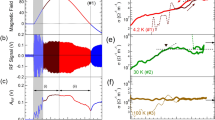Abstract
We calculate properties of Kondo alloys in which superconductivity is induced by the proximity effect, taking account of the energy dependence as well as the temperature dependence of pair-breaking, using the phenomenological model of Müller-Hartmann, Schuh, and Zittartz. The reentrant behavior of the transition temperature is significantly reduced when the energy dependence of pair-breaking is included. The specific heat jump can distinguish between different theories of superconductivity in Kondo alloys. Measurements of the maximum dc Josephson current could indicate the temperature dependence of the order parameter and pair-breaking away from the transition temperature at higher impurity concentrations (a regime for which theoretical predictions are unreliable for both induced and intrinsic Kondo superconductors).
Similar content being viewed by others
References
A. B. Kaiser,Phys. Rev. B 22, 2323 (1980).
W. L. McMillan,Phys. Rev. 175, 537 (1968); E. L. Wolf,Solid State Phys. 30, 1 (1975).
E. Müller-Hartmann and J. Zittartz,Phys. Rev. Lett. 26, 428 (1971).
L. Dumoulin, E. Guyon, and P. Nedellec,Phys. Rev. B 16, 1086 (1977).
J. Zittartz, A. Bringer, and E. Müller-Hartmann,Solid State Commun. 10, 513 (1972).
A. B. Kaiser,J. Phys. C 3, 410 (1970).
T. Matsuura, S. Ichinose, and Y. Nagaoka,Prog. Theor. Phys. 57, 713 (1977); T. Matsuura,Prog. Theor. Phys. 57, 1823 (1977).
A. B. Kaiser,J. Phys. F 7, L339 (1977).
L. Dumoulin, E. Guyon, and P. Nedellec,J. Phys. (Paris)34, 1021 (1973).
B. Schuh and E. Müller-Hartmann,Z. Phys. B 29, 39 (1978).
E. Müller-Hartmann, B. Schuh, and J. Zittartz,Solid State Commun. 19, 439 (1976).
A. Gilabert, C. Van Haesendonck, L. Van den dries, and Y. Bruynseraede,J. Low Temp. Phys. 39, 373 (1980).
N. Mori,J. Low Temp. Phys. 43, 107 (1981).
K. Matsui and Y. Masuda,J. Phys. Soc. Japan 46, 1444 (1979);J. Low Temp. Phys. 31, 101 (1978).
A. B. Kaiser and M. J. Zuckermann,Phys. Rev. B 1, 229 (1970).
S. Mohabir and A. D. S. Nagi,J. Low Temp. Phys. 36, 307 (1979).
M. Abramowitz and I. A. Stegun,Handbook of Mathematical Functions (Dover, New York, 1965), pp. 258–260.
H. Shiba,Prog. Theor. Phys. 50, 50 (1973).
E. Müller-Hartmann and J. Zittartz,Z. Physik 256, 366 (1972).
A. Gilabert, C. Van Haesendonck, L. Van den dries, and Y. Bruynseraede,Solid State Commun. 31, 109 (1979).
J. Zittartz, inProc. 12th Int. Conf. Low Temp. Phys. (Academic Press of Japan, Kyoto, Japan, 1971), p. 647.
K. Maki,Phys. Rev. 153, 428 (1967).
Author information
Authors and Affiliations
Rights and permissions
About this article
Cite this article
Kaiser, A.B., Keleher, C.J. Transition temperature, specific heat, and dc Josephson effect for induced superconducting Kondo alloys. J Low Temp Phys 48, 1–12 (1982). https://doi.org/10.1007/BF00681714
Received:
Revised:
Issue Date:
DOI: https://doi.org/10.1007/BF00681714




